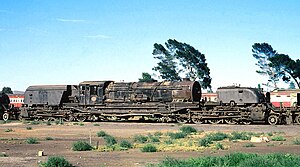SAR class GO
| SAR class GO | |
|---|---|
|
GO No. 2592 retired and parked in the De Aar locomotive depot, South Africa
|
|
| Numbering: | 2572-2596 |
| Number: | 25th |
| Manufacturer: | Henschel |
| Year of construction (s): | 1954 |
| Retirement: | 1975 |
| Type : | (2'D1 ') (1'D2') h4 (Garratt) |
| Gauge : | 1067 mm ( cape track ) |
| Length over coupling: | 28,750 mm |
| Service mass: | 178 t |
| Friction mass: | 111.1 t |
| Wheel set mass : | 13.9 t |
| Driving wheel diameter: | 1,371 mm |
| Impeller diameter: | k. A. |
| Cylinder diameter: | 470 mm |
| Piston stroke: | 660 mm |
| Boiler overpressure: | 138 N / cm² |
| Grate area: | 5.26 m² |
| Radiant heating surface: | 21.46 m² |
| Tubular heating surface: | 202.2 m² |
| Superheater area : | 50.7 m² |
| Train brake: | Suction air brake |
The vehicles of the GO class of the South African Railways (SAR) are articulated locomotives of the Garratt design . 25 pieces were delivered by Henschel in 1954 .
Running gear and engine (apart from the reduced cylinder diameter) as well as the technical equipment of the locomotives correspond to the GMA / GMAM class ; the machines are therefore equipped with cast steel frames , roller bearings and stokers . The boiler is smaller than the GMA / GMAM class, however, so that the axle load could be reduced from 15.2 to 13.9 t and the locomotives were also suitable for routes with a weaker superstructure. Like the classes GM and GMA / GMAM, the class GO only has a relatively small water supply (7.5 t) on the locomotive itself, and a water tender (tank car) was always carried on the line service.
The GO class locomotives were stationed in Lydenburg for most of their service life and served the route between Belfast and Steelpoort in the East Transvaal . The mountainous route crosses the highest point of the South African railway network with 2096 m and has gradients of 30 ‰.
In 1972, the GO were replaced by diesel locomotives on this route and relocated to Transkei . However, they were not very popular there because their power was a little too low to replace two class 14CRB locomotives and their larger fixed wheelbase compared to the class 14 also led to poor running behavior in tight corners. The locomotives therefore came to the north coast of Natal to Empangeni and Stanger , where they replaced older Garratts of the GE class . In 1975 these routes were also converted to diesel operation, and the entire GO class was taken out of service relatively early and parked in De Aar .
A locomotive (No. 2575) will be kept operational for special trips.
literature
- AE Durrant: Garratt locomotives of the world. Birkhäuser, Basel et al. 1984, ISBN 3-7643-1481-8 .
